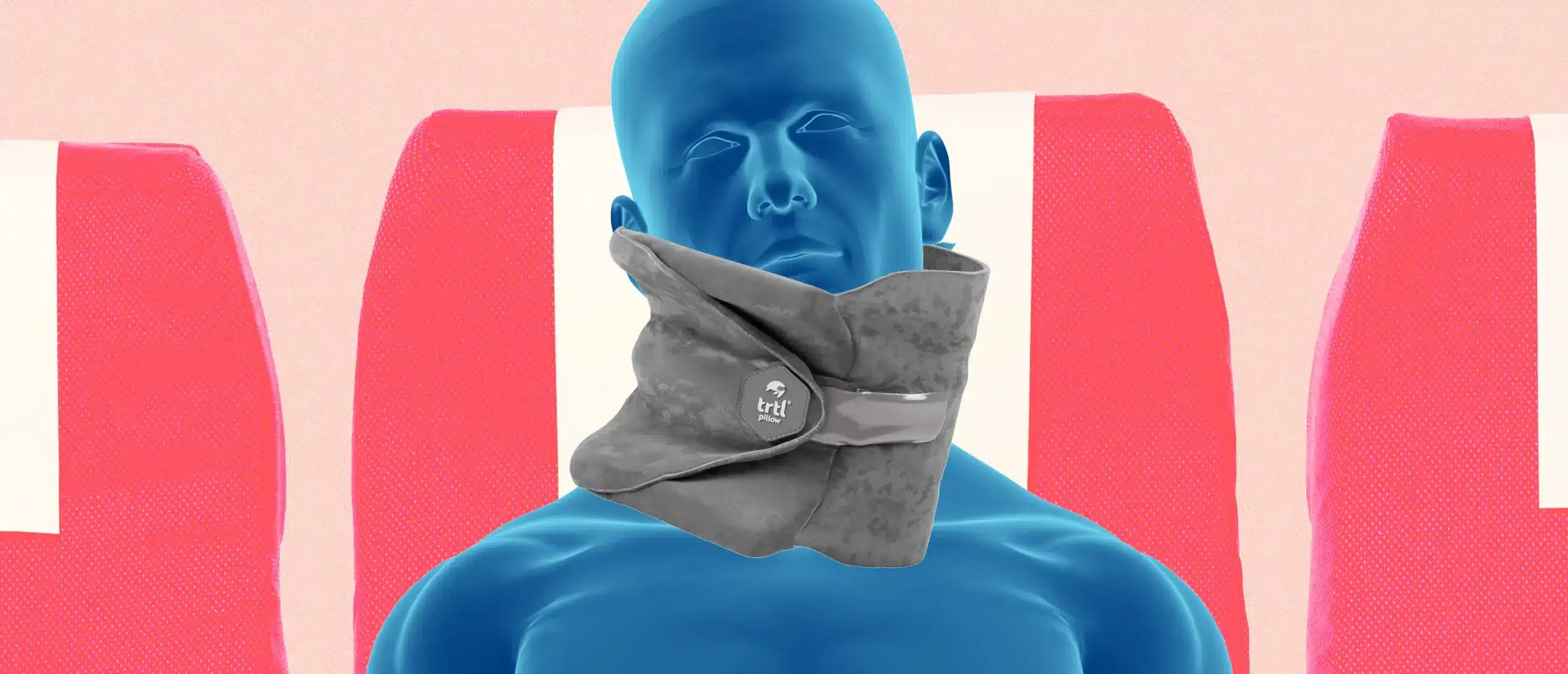This Travel Pillow Will Single-Handedly Make You a Plane Sleeper
Though deep within me I know the seats in Economy Class were designed not for comfort but for maximizing airline revenue, I am still taken aback by the seat design in commercial airplanes. And while there is a veritable cornucopia of bones to pick with these “seats,” it is the headrest that deserves most of our ire. It isn’t soft, and the sides of it fold in slightly, offering a teasing glance at what it should do, but does not—hold your head up.
Enter, Trtl, a $50 travel pillow that was suggested to me by my pilot brother-in-law. It shares little with the horseshoe-shaped abominations of which you are no doubt familiar—nay, it is more neck brace than pillow, and I’d put all my frequent flyer miles down that you’ll come to love it. Here’s what you need to know.
Our Experience
Hone Health is a team of health-obsessed journalists, editors, fitness junkies, medical reviewers, and product testers. I have spent a lifetime of traveling searching for solutions to the problem of neck support on planes—from the god-forsaken horseshoe neck ring to bundling several hoodies into something approximating a pillow. If you’ve ever woken up at your destination with a neck so stiff it feels as though WD-40 is your only solution, you know the struggle.
What Is the Trtl Travel Neck Pillow?
Though it is called a travel neck pillow, Trtl is functionally a one-sided neck brace. The primary brace is a flexible plastic frame wrapped in fleece with a lengthy, unstructured fleece arm. To put the Trtl pillow on, you place the brace frame on the side of your head you tend to lean toward when nodding off and wrap the fleece arm around your neck once and secure it with Velcro.

What’s Good About the Trtl Travel Neck Pillow?
Mitigates neck pain on flights
I’m blessed to be able to sleep on planes, which means I’m cursed to suffer the consequences of said sleep. Typically, those consequences would manifest as the stiffest neck imaginable, ruining the first day at whatever destination I was flying to. About 90 minutes into my first flight wearing the Trtl pillow I knew that was no longer going to be a problem.
The brace in the pillow has some give, but not much, and stiffens only when force is applied to it—AKA when you pass out or lean your head against it. The design is simple yet effective. Because the bottom of the brace rests on your shoulder and clavicle, it’s always supported (so long as you’re seated in an upright position, which all of us Economy class passengers are). Your neck does none of the work to keep your bowling ball of a head upright, which means it literally cannot become sore or strained.
Research on this subject is thin at best, with the vast majority of it focusing more on alternative pillow shapes and materials for bed sleeping rather than plane sleeping. In any case, there are studies that show sleeping with more structural support can reduce nonspecific neck pain.
Miles better than competition
After using a Trtl pillow for a period, it’s difficult to take the traditional travel pillow seriously as a tool for genuine, long-lasting comfort on any flight longer than an hour.
The traditional travel pillow is some kind of soft material stuffed with more soft material, usually fashioned in a U-shape. No matter if you wear it with the open part of the U in the front or the back (there is much debate about this, funnily enough), a pillow with no real support can’t support your head—which weighs 10 to 15 pounds—for any significant period of time. You may feel supported initially, but the filling of the pillow (foam, microbeads, cotton, etc.) is simply not meant to hold that much weight. It will eventually depress under that load, forcing your neck to tense in order to keep yourself upright while asleep.
This is why travel pillows desperately need structure—they have a lot more work to do than the cushy pillows you typically sleep with. The Trtl pillow provides that, which is far more comfortable in the long run.
Packs away nicely
I’m not ashamed to admit I am a “but what if the worst happened?” kind of packer (a nice euphemism for over-packing). Put simply, the Trtl pillow takes up significantly less space than the weirdly thick travel pillows I used to fly with. It slides down the front or back of my carry-on backpack without issue, and springs back into shape when I take it out.
What’s Not Good About the Trtl Travel Neck Pillow?
Can feel stuffy on warm flights
The fault with using the neck and shoulders as a base for supporting the head is clear: things get pretty warm. Whether you have the Trtl pillow or a traditional travel pillow, you may start to feel a little too warm on those flights which the A/C seems to be lacking. I noticed this on a flight returning from the Dominican Republic especially, as it was 95 degrees and humid boarding the plane and I was properly hot once seated. There isn’t an easy solution, though Trtl has released a cooling version of the same neck pillow which costs $20 more and was designed with thermoregulation in mind, using chiller fabrics like Tencel to draw heat away from the wearer.
Doesn’t seem durable
My biggest gripe with Trtl pillows is my perception of their durability. Mine simply does not feel like it’s going to last me longer than a couple years before some of the fabric tears (my money is on the Velcro tearing away from the fleece) or it loses tension in the neck brace.
To be clear, my fears have not year been realized—the thing is still very much in good condition after six flights—but a frayed edge here and a loose thread there leads me to believe that I’ll be buying another one in the next two years or so.
The Bottom Line
Despite the Trtl travel pillow feeling a bit cheap, it’s simply so much better at what it’s designed to do—support your head while sleeping on a plane—that I wholeheartedly believe it’s worth the $50 price tag for anyone who sleeps on planes.











